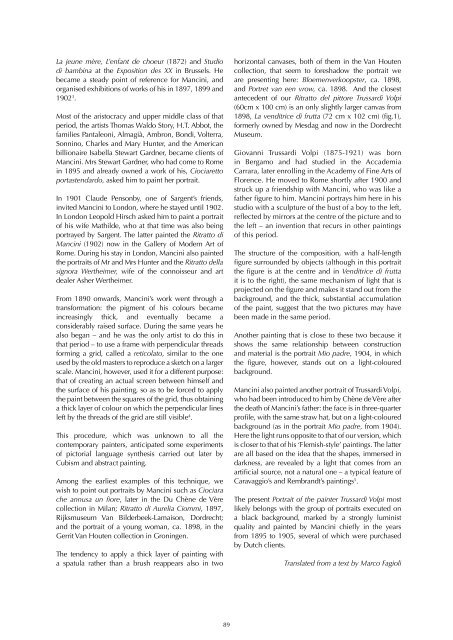You also want an ePaper? Increase the reach of your titles
YUMPU automatically turns print PDFs into web optimized ePapers that Google loves.
La jeune mère, L’enfant de choeur (1872) and Studio<br />
di bambina at the Exposition des XX in Brussels. He<br />
became a steady point of reference for Mancini, and<br />
organised exhibitions of works of his in 1897, 1899 and<br />
1902 3 .<br />
Most of the aristocracy and upper middle class of that<br />
period, the artists Thomas Waldo Story, H.T. Abbot, the<br />
families Pantaleoni, Almagià, Ambron, Bondi, Volterra,<br />
Sonnino, Charles and Mary Hunter, and the American<br />
billionaire Isabella Stewart Gardner, became clients of<br />
Mancini. Mrs Stewart Gardner, who had come to Rome<br />
in 1895 and already owned a work of his, Ciociaretto<br />
portastendardo, asked him to paint her portrait.<br />
In 1901 Claude Pensonby, one of Sargent’s friends,<br />
invited Mancini to London, where he stayed until 1902.<br />
In London Leopold Hirsch asked him to paint a portrait<br />
of his wife Mathilde, who at that time was also being<br />
portrayed by Sargent. The latter painted the Ritratto di<br />
Mancini (1902) now in the Gallery of Modern Art of<br />
Rome. During his stay in London, Mancini also painted<br />
the portraits of Mr and Mrs Hunter and the Ritratto della<br />
signora Wertheimer, wife of the connoisseur and art<br />
dealer Asher Wertheimer.<br />
From 1890 onwards, Mancini’s work went through a<br />
transformation: the pigment of his colours became<br />
increasingly thick, and eventually became a<br />
considerably raised surface. During the same years he<br />
also began – and he was the only artist to do this in<br />
that period – to use a frame with perpendicular threads<br />
forming a grid, called a reticolato, similar to the one<br />
used by the old masters to reproduce a sketch on a larger<br />
scale. Mancini, however, used it for a different purpose:<br />
that of creating an actual screen between himself and<br />
the surface of his painting, so as to be forced to apply<br />
the paint between the squares of the grid, thus obtaining<br />
a thick layer of colour on which the perpendicular lines<br />
left by the threads of the grid are still visible 4 .<br />
This procedure, which was unknown to all the<br />
contemporary painters, anticipated some experiments<br />
of pictorial language synthesis carried out later by<br />
Cubism and abstract painting.<br />
Among the earliest examples of this technique, we<br />
wish to point out portraits by Mancini such as Ciociara<br />
che annusa un fiore, later in the Du Chène de Vère<br />
collection in Milan; Ritratto di Aurelia Ciommi, 1897,<br />
Rijksmuseum Van Bilderbeek-Lamaison, Dordrecht;<br />
and the portrait of a young woman, ca. 1898, in the<br />
Gerrit Van Houten collection in Groningen.<br />
The tendency to apply a thick layer of painting with<br />
a spatula rather than a brush reappears also in two<br />
horizontal canvases, both of them in the Van Houten<br />
collection, that seem to foreshadow the portrait we<br />
are presenting here: Bloemenverkoopster, ca. 1898,<br />
and Portret van een vrow, ca. 1898. And the closest<br />
antecedent of our Ritratto del pittore Trussardi Volpi<br />
(60cm x 100 cm) is an only slightly larger canvas from<br />
1898, La venditrice di frutta (72 cm x 102 cm) (fig.1),<br />
formerly owned by Mesdag and now in the Dordrecht<br />
Museum.<br />
Giovanni Trussardi Volpi (1875-1921) was born<br />
in Bergamo and had studied in the Accademia<br />
Carrara, later enrolling in the Academy of Fine Arts of<br />
Florence. He moved to Rome shortly after 1900 and<br />
struck up a friendship with Mancini, who was like a<br />
father figure to him. Mancini portrays him here in his<br />
studio with a sculpture of the bust of a boy to the left,<br />
reflected by mirrors at the centre of the picture and to<br />
the left – an invention that recurs in other paintings<br />
of this period.<br />
The structure of the composition, with a half-length<br />
figure surrounded by objects (although in this portrait<br />
the figure is at the centre and in Venditrice di frutta<br />
it is to the right), the same mechanism of light that is<br />
projected on the figure and makes it stand out from the<br />
background, and the thick, substantial accumulation<br />
of the paint, suggest that the two pictures may have<br />
been made in the same period.<br />
Another painting that is close to these two because it<br />
shows the same relationship between construction<br />
and material is the portrait Mio padre, 1904, in which<br />
the figure, however, stands out on a light-coloured<br />
background.<br />
Mancini also painted another portrait of Trussardi Volpi,<br />
who had been introduced to him by Chène de Vère after<br />
the death of Mancini’s father: the face is in three-quarter<br />
profile, with the same straw hat, but on a light-coloured<br />
background (as in the portrait Mio padre, from 1904).<br />
Here the light runs opposite to that of our version, which<br />
is closer to that of his ‘Flemish-style’ paintings. The latter<br />
are all based on the idea that the shapes, immersed in<br />
darkness, are revealed by a light that comes from an<br />
artificial source, not a natural one – a typical feature of<br />
Caravaggio’s and Rembrandt’s paintings 5 .<br />
The present Portrait of the painter Trussardi Volpi most<br />
likely belongs with the group of portraits executed on<br />
a black background, marked by a strongly luminist<br />
quality and painted by Mancini chiefly in the years<br />
from 1895 to 1905, several of which were purchased<br />
by Dutch clients.<br />
Translated from a text by Marco Fagioli<br />
89
















